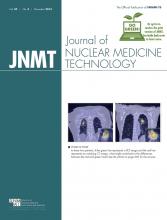Abstract
Bone scanning is an important technique to detect mandibular growth, and its quantitation aids in deciding the optimal timing for surgery. Here, we will discuss a case of abnormal mandibular growth and use of bone scanning to evaluate the facial bone growth.
This case study demonstrates how 99mTc-MDP bone scanning can evaluate facial bone growth and help determine the next course of treatment for mandibular growth disorder.
CASE REPORT
A 31-y-old woman had a history of right mandibular pain due to abnormal mandibular growth. A bone scan was ordered to evaluate the mandibular growth. Four hours after the administration of 821.77 MBq (22.21 mCi) of 99mTc-methylene diphosphonate (MDP), anterior and posterior views of the skull, right and left lateral views of the skull, and posterior views of the lumbosacral spine were obtained. Regions of interest were selected, and the ratios of uptake in the mandible were obtained and compared with those of the L4 vertebra (Fig. 1; Table 1).
Bone scans showing the regions of interests.
Ratio of Uptake in Mandible Compared with L4 Vertebra
DISCUSSION
The ability to predict the cessation of facial bone growth before surgery is crucial in patients with mandibular prognathism, as well as in patients with unilateral condylar hyperactivity (1,2). Various imaging techniques such as hand and wrist radiographs, cephalograms, and 99mTc-MDP bone scintigraphy are currently used to determine when facial bone growth has stopped, so that surgery can be most effective. Radiographs compare the growth of the hand and wrist with that of the mandible; however, the mandible tends to grow even after the hand and wrist mature. Cephalograms require 2 separate observations, months apart, yet cannot predict future growth (1).
99mTc-MDP bone scintigraphy is able to view osteogenic activity, allowing for visualization and comparison of the growth of the left and right condyles of the mandible. The condylar region is compared with the lumbar vertebra, and the ratio is determined. Patients with ratios of less than 1 are considered eligible for surgery, but ratios greater than 1 lead to delay of any surgical procedures.
Obtaining a thorough history is important because bone activity can also indicate remodeling after recent trauma. A study performed at Universidade Gama Filho and Hospital Universitário Pedro Ernesto in Rio de Janeiro, Brazil, emphasized the ability of 99mTc-MDP to visualize the metabolic status earlier than other methods (1). We used the same method and regions of comparison during our study. The ratio determined by selecting regions of interest on the right and left body and rami condyles of the mandibles compared with the L4 vertebra was less than 1; therefore, surgery was a viable option.
Bone scanning is an important technique that detects mandibular growth, and its quantitation aids in deciding the optimal timing for surgery.
DISCLOSURE
No potential conflict of interest relevant to this article was reported.
Footnotes
Published online Aug. 28, 2014.
REFERENCES
- Received for publication March 16, 2014.
- Accepted for publication April 8, 2014.








